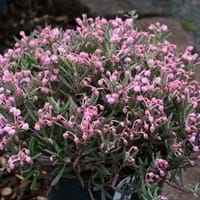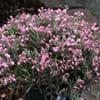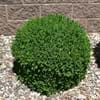Life Span
Annual and Perennial
Perennial
Type
Broadleaf Evergreen
Vegetable
Origin
North America, Europe, Asia
Hybrid origin, Mexico, Central America, South America
Types
Andromeda polifolia var. polifolia, Andromeda polifolia var. glaucophylla
Not Available
Number of Varieties
Not Available
Habitat
Bog Garden, Fens, Swamps
Coastal Regions
USDA Hardiness Zone
2-6
11-15
AHS Heat Zone
Not Available
12-1
Sunset Zone
Not Available
A1, A2, A3, H1, H2, 1a, 1b, 2a, 2b, 3a, 3b, 4, 5, 6, 7, 8, 9, 10, 11, 12, 13, 14, 15, 16, 17, 18, 19, 20, 21, 22, 23, 24
Habit
Cushion/Mound-forming
Upright/Erect
Flower Color
White, Pink, Light Pink
Yellow
Flower Color Modifier
Not Available
Bicolor
Fruit Color
Not Available
Red
Leaf Color in Spring
Gray Green
Green, Dark Green
Leaf Color in Summer
Gray Green
Green, Dark Green
Leaf Color in Fall
Gray Green
Green, Dark Green
Leaf Color in Winter
Gray Green
Green, Dark Green
Leaf Shape
Long Linear
Ovate
Plant Season
Spring, Summer, Fall, Winter
Spring, Summer, Fall
Sunlight
Full Sun, Partial Sun, Partial shade
Full Sun
Type of Soil
Loam
Loam, Sand
The pH of Soil
Acidic
Neutral
Soil Drainage
Average
Well drained
Bloom Time
Late Spring, Early Summer
Indeterminate
Tolerances
Not Available
Drought
Where to Plant?
Container, Ground
Container, Ground
How to Plant?
Seedlings
Grafting, Seedlings
Plant Maintenance
Medium
Medium
Watering Requirements
Do not let dry out between waterings, Keep ground moist
Needs more water during establishment
In Summer
Average Water, Ample Water
Lots of watering
In Spring
Ample Water
Moderate
In Winter
Not so frequently
Average Water
Soil Type
Loam
Loam, Sand
Soil Drainage Capacity
Average
Well drained
Sun Exposure
Full Sun, Partial Sun, Partial shade
Full Sun
Pruning
Prune for size control, Remove short twigs
Pinch or prune as they grow to promote branching and bushiness
Fertilizers
fertilize in spring
14-14-14 Fertilizer, Compost
Pests and Diseases
No serious insect or disease problems
Anthracnose, Aphids, Red blotch, Rust
Plant Tolerance
Not Available
Heat Tolerance, Salt and Soil Compaction
Flower Petal Number
Single
Single
Fragrant Bark/Stem
No
Yes
Foliage Texture
Fine
Medium
Foliage Sheen
Matte
Matte
Attracts
pollinators
Aphids, Not Available, Squirrels
Allergy
Not Available
Stomach pain, Vomiting
Aesthetic Uses
Showy Purposes
Used in parkland
Beauty Benefits
Not Available
Anti-ageing, Blackheads, Reduce Bruises
Environmental Uses
Not Available
Shadow Tree, Soil protection
Medicinal Uses
Not Available
Dehydration, Diabetes, Diarrhea, Nutrients, Weight loss
Part of Plant Used
Flowers
Fruits
Other Uses
As a tea substitute
Application in Handicrafts, Food for animals, Showy Purposes
Used As Indoor Plant
No
No
Used As Outdoor Plant
Yes
Yes
Garden Design
Bog Garden, Container, Mixed Border, Rock Garden, Wall
Edible, Herb, Vegetable
Botanical Name
ANDROMEDA polifolia
Manilkara zapota
Common Name
Bog Rosemary
sapodilla , chikoo, Sapota
In Hindi
Bog Rosemary
चीकू
In German
Rosmarinheide
Breiapfelbaum
In French
Andromeda polifolia
Sapotillier
In Spanish
Andromeda polifolia
chicle
In Greek
Bog Rosemary
sapodilla
In Portuguese
Bog Rosemary
sapodilla
In Polish
Modrzewnica zwyczajna
Pigwica właściwa, sapodilla
In Latin
Bog Rosemary
sapodilla
Phylum
Magnoliophyta
Magnoliophyta
Class
Magnoliopsida
Magnoliopsida
Family
Ericaceae
Sapotaceae
Clade
Angiosperms, Asterids, Eudicots
Angiosperms, Asterids, Eudicots
Tribe
Not Available
Sapoteae
Subfamily
Vaccinioideae
Sapotoideae
Season and Care of Bog Rosemary and Sapodilla
Season and care of Bog Rosemary and Sapodilla is important to know. While considering everything about Bog Rosemary and Sapodilla Care, growing season is an essential factor. Bog Rosemary season is Spring, Summer, Fall and Winter and Sapodilla season is Spring, Summer, Fall and Winter. The type of soil for Bog Rosemary is Loam and for Sapodilla is Loam, Sand while the PH of soil for Bog Rosemary is Acidic and for Sapodilla is Neutral.
Bog Rosemary and Sapodilla Physical Information
Bog Rosemary and Sapodilla physical information is very important for comparison. Bog Rosemary height is 33.00 cm and width 46.00 cm whereas Sapodilla height is 150.00 cm and width 60.00 cm. The color specification of Bog Rosemary and Sapodilla are as follows:
Bog Rosemary flower color: White, Pink and Light Pink
Bog Rosemary leaf color: Gray Green
Sapodilla flower color: Yellow
- Sapodilla leaf color: Green and Dark Green
Care of Bog Rosemary and Sapodilla
Care of Bog Rosemary and Sapodilla include pruning, fertilizers, watering etc. Bog Rosemary pruning is done Prune for size control and Remove short twigs and Sapodilla pruning is done Pinch or prune as they grow to promote branching and bushiness. In summer Bog Rosemary needs Average Water, Ample Water and in winter, it needs Not so frequently. Whereas, in summer Sapodilla needs Lots of watering and in winter, it needs Average Water.




